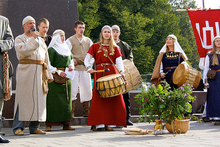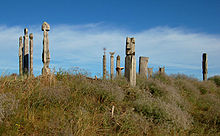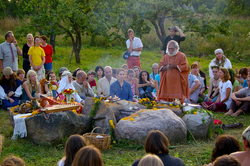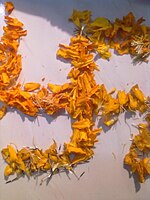Romuva (religion)
| Romuva | |
|---|---|
 Flag of the Romuva religion | |
| High priestess (krivė) | Inija Trinkūnienė (2015–present) |
| Founder | Vydūnas |
| Origin | 20th century |
| Members | ~5,100 (2011) |
| Official website | romuva.lt |
Romuva is a
Romuva primarily exists in Lithuania but there are also congregations of adherents in Australia, Canada, Russia, the United States,
Etymology
The terms Romuva, Romovė, and Ruomuva came from medieval written sources in
History
Ancient and medieval Lithuanian faith


Whatever religion the original inhabitants of the Baltic region had predates recorded history.
The adherents of this Baltic religion prospered relatively unhindered until the 9th century when they began to come under pressure from outside Christian forces.
Beginning in 1199, the Roman Catholic Church declared
Even in the face of Crusaders, by the time of Grand Duke
Revival
The
In the beginning of the 20th century, ancient pagan traditions were still continued in folklore and customs.
Modern folk religion
The philosopher Vydūnas is taken as a sort of founding father of Romuva.[32] He actively promoted awareness of and participation in pagan festivals.[32] Vydūnas saw Christianity as foreign to Lithuanians, and instead he brought his attention to what he saw as the spiritual vision of the adherents of the traditional Baltic religion. He ascribed to this a sense of awe in their cosmology, as they saw the universe as a great mystery, and respect for every living being as well as the earth in their morality, as they saw the whole world and every individual as a symbol of life as a whole.[33] The Divine was represented by fire, which was as such used ritually to worship the divine and itself held sacred. Vydūnas had given special treatment to this religion of the Lithuanians in his drama Amžina ugnis (An Eternal Flame). Among this and other works, Vydūnas exalted the faith as being on the highest level of spiritual expression, along with other forms which he recognized.[34]
Domas Šidlauskas-Visuomis (1878–1944) began to create Vaidevutybė (Baltic paganism) in 1911. In the 1920s the Latvian folk religion movement Dievturība was started by Ernests Brastiņš. The main problem was that the first movements were based on limited folklore sources and influenced by Far Eastern traditions such as Hinduism and Buddhism. Even so, the idea of Romuva did not die during the Soviet occupation of Lithuania.
Soviet suppression
The Lithuanian pagan movement was stopped by
A clandestine Romuva group is known to have existed within a labor camp in
Independence

After Lithuania regained independence in 1990, Romuva was recognised as an Ancient Baltic faith community in 1992. Under the auspices of the Law on Religious Communities and Associations which was passed in Lithuania in 1995, Romuva gained recognition as a "non-traditional" religion. The law requires a minimum of 25 years of existence before such a religion can receive the state support reserved for "traditional" religions.
In 1990, Trinkūnas created
On 24 May 2018, Seimas passed a proposal for granting state recognition to Romuva and began discussing it in the parliamentary committees.[38] In June 2019, Seimas voted to reject Romuva's petition to be recognized as a "traditional" religion. The law provides that the petition could be resubmitted in ten years. The proposal was opposed mainly by the members of the Homeland Union, particularly by Žygimantas Pavilionis.[39] Romuva sued Lithuania in the European Court of Human Rights and won a unanimous decision in June 2021 that the Seimas did not remain "neutral and impartial in exercising their regulatory powers". Romuva will be allowed to reapply for recognition after three months of the ruling.[40]
Religious practices
The Baltic aukuras or "
A Romuva priest is known as a vaidila (plural vaidilos), and a Romuva priestess is known as a vaidilutė (plural vaidilutės). As a recognised figure of authority in his or her community, the priest must have the proper skills and knowledge he or she needs to conduct religious ceremonies to honour the Gods.
A Romuva shrine is a field with one or several idols in front of a sacred fire where sacrifices are burned, known as an alka.
Romuva centres

Samogitian Sanctuary was originally planned to be rebuilt on Birutė hill in Palanga but was not agreed to by the mayor of Palanga. Instead, it was built on a hill near Šventoji which also has 11 sculptures of pagan gods. There are four main festivals in a year:
- 23 March – Vernal equinox
- 22 June – Summer solstice
- 23 September – Autumnal equinox
- 20 December – Winter solstice
Relation with Hinduism
The Romuva religion shares similarities with Hinduism. For example, in
Similarly Ašvieniai are

Romuva and Hindu groups have come together on numerous occasions to share prayers and participate in dialogue. These events have taken place in Lithuania, and elsewhere.
See also
- Historical background
- Baltic neopaganism
- Lithuanian mythology
- List of Lithuanian gods
- Other Neopagan movements
- Dievturība – Latvian
- Rodnovery– Slavic
- European Congress of Ethnic Religions
Notes
- ^ Dundzila (2007), pp. 279, 296-298.
- ^ Dundzila and Strmiska (2005), p. 247.
- ^ Ignatow (2007), p. 104.
- ^ Dundzila and Strmiska (2005), p. 244.
- ^ Dundzila and Strmiska (2005), p. 278.
- ^ Saulėgrįža Londono Romuvoje
- ^ Londono Romuva kviečia
- ^ Rasos šventė Londone
- ^ a b Dundzila (2007), p. 294.
- ^ Naylor, Aliide (31 May 2019). "Soviet power gone, Baltic countries' historic pagan past re-emerges". Religion News Service. Retrieved 8 June 2019.
- ^ Dundzila & Strmiska (2005), p. 246.
- ^ Ignatow (2007), p. 102.
- ISBN 9986231132. p. 267.
- ^ Sergei Anatolyevich Starostin. "*(e)remǝ-". Indo-European etymology.
- ^ a b Dundzila (2007), p. 280.
- ^ a b c d Dundzila (2007), p. 287.
- ^ Georg Heinrich Pertz et al. (ed.): Scriptores (in Folio) 3: Annales, chronica et historiae aevi Saxonici. Hanover, 1839, pp. 80 (Monumenta Germaniae Historica, 80 digitalised)
- ^ Clark (2004), p. 196
- ^ Alfredas Bumblauskas, "Lietuvos tūkstantmetis".
- ^ Dundzila (2007), pp. 287–288.
- ^ a b c Dundzila (2007), p. 288.
- ^ Dundzila & Strmiska (2005), p. 242.
- ^ Dundzila (2004), p. 290.
- ^ Waldman & Mason (2006), p. 492.
- ^ Dundzila & Strmiska (2005), p. 244.
- ^ Barr (2010), p. 179.
- ^ Dundzila (2007), pp. 279 & 292.
- ^ Dundzila & Strmiska (2005), pp. 245–246 & 258.
- ^ a b Dundzila (2007), p. 321.
- ^ Dundzila & Strmiska (2005), pp. 258–270.
- ^ Dundzila & Strmiska (2005), pp. 258–260.
- ^ a b Dundzila & Strmiska (2005), p. 361.
- ^ Dundzila (2007), p. 292.
- ^ Bagdonavicius (2000), p. 96.
- ^ For most of the claims in this paragraph thus far, see Dundzila (2007), p. 293. For Trikūnas' involvement with Ramuva, see Dundzila & Strmiska (2005), p. 246.
- DELFI. Retrieved 23 January 2014.
- ^ "Pirmąsyk istorijoje Lietuvos pagonims vadovaus moteris". Ekspertai.eu. Retrieved 27 May 2015.
- ^ "Seimas to discuss granting state recognition to Lithuanian Neopagans". Delfi. 25 May 2018. Retrieved 27 February 2019.
- Delfi.lt. Retrieved 22 June 2021.
- ^ BNS (13 June 2021). "Neopagans could reapply for recognition in three months' time". Retrieved 22 June 2021.
- Ozy. Retrieved 12 March 2018.
- ^ a b Sharm, Saurabh (12 September 2013). "Lithuanian tribe traces Rajput roots". The Times of India. Retrieved 27 February 2019.
- ^ a b Hamacher, Duane W. "The Sumerians and Gemini: Sumerian Astronomical Interpretations as Origins of the Divine Horse Twins and Solar Chariots in Indo-European Mythology (Unpublished manuscript)" (PDF). p. 7. Archived from the original (PDF) on 14 May 2011.
- ^ "Romuva movement". Lietuvos–Indijos forumas. 2011.
- ^ "Indo Romuva Culture Conference Announced". Hinduism Today. 12 June 2003.
References
- Bagdonavicius, Vaclovas (2000). "Vydunas: the Essential Features of his Philosophy". In Baranova, Jurate (ed.). Lithuanian Philosophy: Persons and Ideas. Council for Research in Values. ISBN 9781565181373.
- Baár, Monika (2010). Historians and Nationalism. Oxford University Press. ISBN 978-0-19-958118-4.
- Clark, Terry D. (2004). "Lithuania". In Frucht, Richard; Ellington, Lucien (eds.). Eastern Europe: An Introduction to the People, Lands, and Culture. ABC-CLIO. ISBN 9781576078006.
- Dundzila, Vilius Rudra; Strmiska, Michael F. (2005). "Romuva: Lithuanian Paganism in Lithuania and America". In Strmiska, Michael F. (ed.). ISBN 9781851096084.
- Dundzila, Vilius Rudra (2007). "Baltic Lithuanian Religion and Romuva". ISBN 978-0-9720292-3-0.
- Kak, Subhash (2018). Romuva and the Vedic Gods of Lithuania. Romuva and the Vedic Gods of Lithuania
- Ignatow, Gabriel (2007). "Cultural Heritage and the Environment in Lithuania". Transnational Identity Politics and the Environment. Lexington Books. ISBN 978-0739120156.
- Waldman, Carl; Mason, Catherine (2006). Encyclopedia of European Peoples. Infobase Publishing. ISBN 9781438129181.
Further reading
- Senvaitytė, Dalia (2018). "The Hunt for Lost Identity: Native Faith Paganism in Contemporary Lithuania". S2CID 197848218.
External links
- Web site of Romuva (in Lithuanian)
- World congress of Ethnic Religions: Romuva
- Romuva (religion) at Curlie


